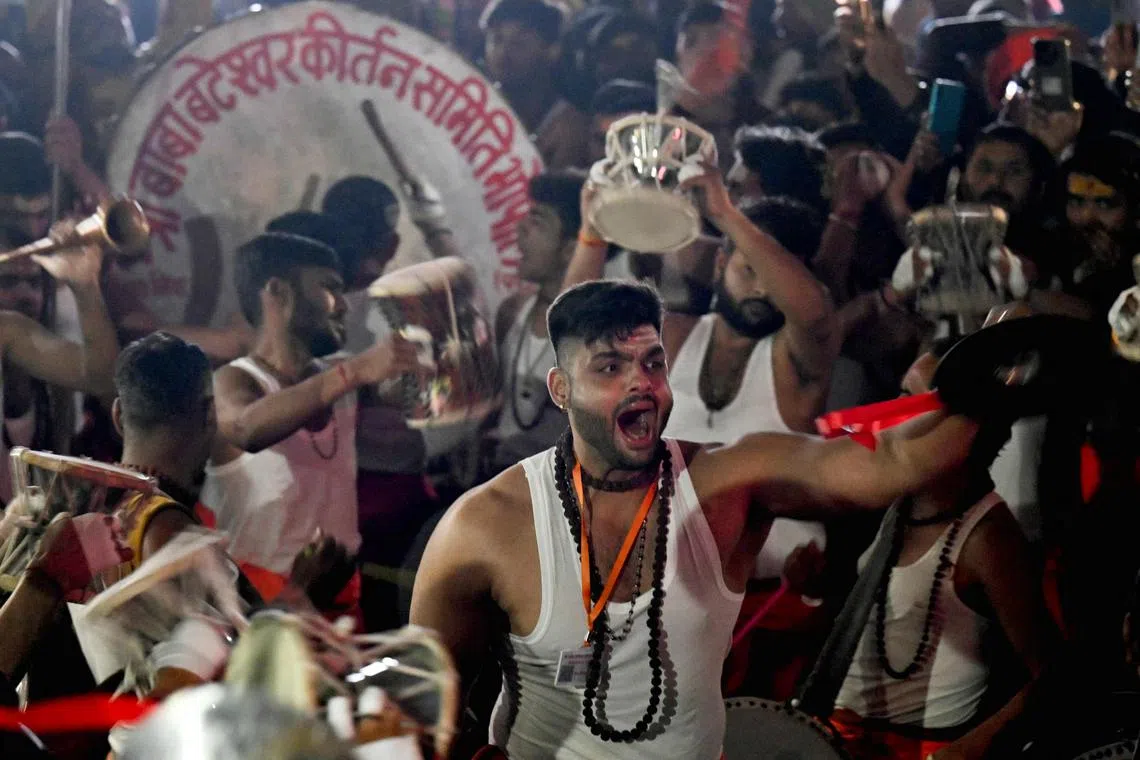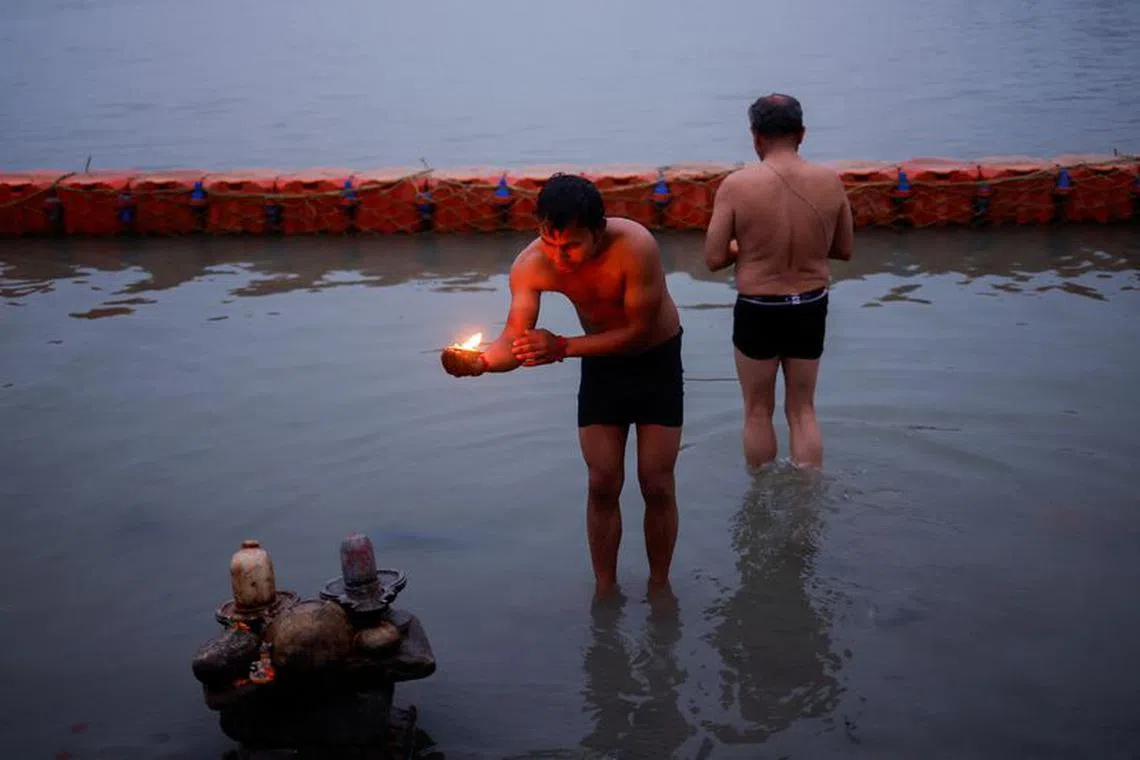India’s Modi leads consecration of grand Ram temple in Ayodhya
Sign up now: Get insights on Asia's fast-moving developments
AYODHYA, India - Indian Prime Minister Narendra Modi on Jan 22 led the consecration of a grand temple to the Hindu god Lord Ram
It was a historic event for the Hindu majority of the world’s most populous nation.
Portrayed as a Hindu awakening from centuries of subjugation by Muslim and colonial powers, the event is also seen as a crucial element in the prelude to Mr Modi’s campaign for a rare third term in a general election due by May.
Mr Modi said the opening of the temple heralded a “new era” for India. “Breaking the shackles of slavery, the country should rise, taking lessons from the past,” he said, speaking outside the temple.
“Jan 22, 2024, is not merely a date in the calendar but heralds the advent of a new era,” he added.
“It’s Ram’s supreme blessings that we are witnessing.”
During the consecration ceremony, Mr Modi chanted Hindu religious verses before placing flower petals at the feet of a 130cm-tall black stone statue of the deity. He then clasped his palms in prayer, bowed before it, and circled a sacred flame. Outside, a military helicopter showered petals on the temple.
Traditional clarinets played devotional music during the rituals for the statue, which represents the god-king, while politicians, businessmen, sports and media stars watched along with millions nationwide. Thousands of saffron-clad people danced in the streets, waving saffron flags as they chanted religious slogans.
“This is a very proud moment for all Hindus,” said Mr Mewaram Prajapati, who came from Mr Modi’s western home state of Gujarat. “Our lord suffered a lot. He stayed in tents, braved heat, cold and rains,” he added, referring to earlier structures at the site. “Now, our god will finally settle in his palace.”
The temple delivers on a key 35-year-old promise by Mr Modi's Hindu nationalist Bharatiya Janata Party (BJP). It has been a contentious political issue that has helped catapult the BJP to prominence and power.
“The lord has made me an instrument to represent all the people of India,” Mr Modi had said ahead of the “auspicious” opening.

The temple delivers on a key 35-year-old promise by PM Narendra Modi’s Hindu nationalist Bharatiya Janata Party.
PHOTO: REUTERS
‘Watershed moment’
The temple’s site was bitterly contested for decades, with both Hindus and Muslims claiming it in a dispute.
In 1992, a Hindu mob destroyed a 16th-century mosque that stood on the site, sparking nationwide riots that killed 2,000 people, mostly Muslims.
India’s Hindus say the site is the birthplace of Lord Ram, and was holy to them long before Muslim Mughals razed a temple at the spot to build the Babri Masjid in 1528.
In 2019, the Supreme Court handed over the land to Hindus and ordered the allotment of a separate plot to Muslims, where a new mosque has yet to be built.

Devotees perform by playing musical instruments in Ayodhya on Jan 21.
PHOTO: AFP
Nearly 8,000 people were invited to the ceremony on Jan 22.
More than 10,000 police personnel fanned out across the city of three million people to provide security and keep out gatecrashers. Security was also stepped up nationwide, especially in cities and towns that have suffered past Hindu-Muslim tensions and strife.
The temple opens to the public on Jan 23 and its management expects at least 100,000 visitors a day for the first few months.
The consecration has ignited religious fervour across India, with many states declaring a holiday on Jan 22, stock markets shut, and homes and businesses illuminated, after Mr Modi called for it to be marked as another Diwali, the Hindu festival of lights.
Commenter Pratap Bhanu Mehta wrote in the Indian Express newspaper: “Just in sheer magnitude... this event has almost no precedent in history. It is a watershed moment.”
‘Destruction’
Since sweeping to power a decade ago, Mr Modi and the BJP have sought to bring the Hindu faith to the forefront of public life.
Party luminaries regularly condemn earlier eras of Islamic rule over parts of India as a time of “slavery” when their own religion was oppressed, with Ayodhya a key plank in their narrative.
The BJP played an instrumental role in public campaigning that eventually led to the Babri Masjid’s demolition.
The destruction presaged the rise of the BJP and Mr Modi as unstoppable electoral juggernauts.

The ceremony in the northern city of Ayodhya is being projected as a historic event for the country's Hindu majority.
PHOTO: REUTERS
They displaced the secularist Congress party that had governed India almost without interruption since independence from Britain.
Mr Modi’s consecration of the temple alongside Hindu priests will again project him as a defender of the faith ahead of a general election expected to begin in April.
The BJP is heavily favoured to win a third successive landslide victory, in part because of Mr Modi’s appeals to Hindu nationalism.

Hindu devotees ahead of an inauguration ceremony for the Ram Temple in Ayodhya, India, on Jan 22.
PHOTO: REUTERS
Opposition parties have boycotted the temple ceremony, saying the event will be a thinly veiled campaign rally.
But many of India’s 200 million Muslims, already anxious in a climate of increased sectarian tensions, have watched the clamour around the temple with trepidation.
Mr Mohammed Shahid, 52, speaking to AFP in December in Ayodhya, recounted how his father was burned alive by a mob.
“For me, the temple symbolises nothing but death and destruction”, he said. REUTERS, AFP

